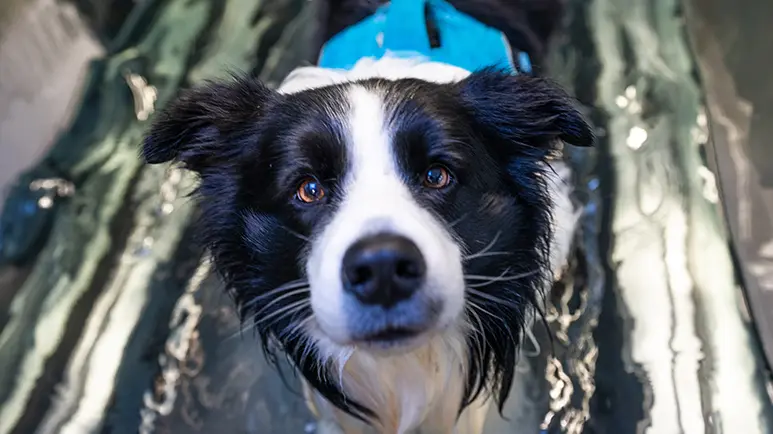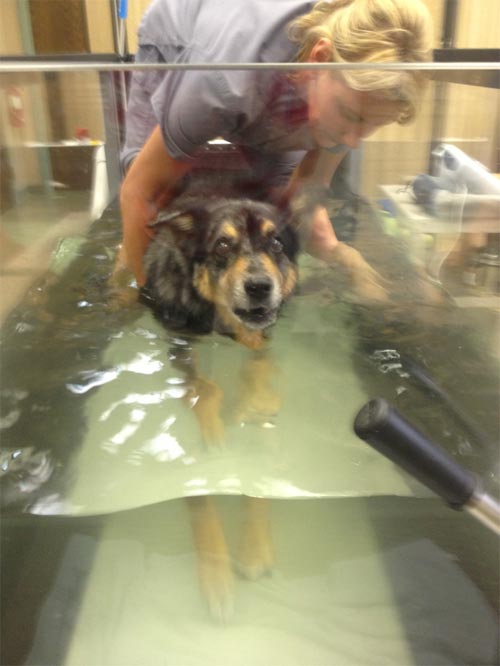This Novel Therapy Helps Injuries Heal While Easing Pain
It's one of my favorite therapies for dogs as it provides countless benefits as well as emotional perks. It's perfect for after surgery or an injury, or if your pet has arthritis or a mobility issue or is getting up in years. If you have a smaller dog, you can do it yourself right at home.

STORY AT-A-GLANCE
- Hydrotherapy, also called aquatic therapy, can provide tremendous healing, pain relief and emotional benefits for dogs
- Injured or postoperative dogs are perfect candidates for aquatic therapy
- Older dogs, especially those with arthritis and mobility issues, can achieve pain relief and renewed confidence with hydrotherapy
- Other canine conditions that can benefit from water movement therapy include gait abnormalities and spinal cord injuries
Editor's Note: This article is a reprint. It was originally published March 24, 2017.
Hydrotherapy, also called aquatic therapy, is one of my favorite physical rehab therapies for pets because moving in water provides countless benefits. It can help injured dogs heal, relieve pain and provide emotional benefits as well.
The purpose of any type of physical therapy is to help the patient, whether human or canine, regain functional ability, optimize movement of all body parts and improve quality of life.
Hydrotherapy Is Perfect for Postoperative Canine Patients
If you have a dog who has had surgery, the role of rehabilitation and especially water therapy can prove invaluable.
A dog's muscles begin to atrophy within just a day or two after an injury or surgery. If rehab isn't started immediately, the area of the wound or injury will show increased swelling due to lack of movement. There can also be loss of muscle control, decreased stability in joints and increased stiffness of tendons and muscles.
Normal weight-bearing activities that would arrest and reverse these conditions often can't be allowed for weeks after surgery. But most dogs can begin passive physical therapy a few days after surgery and aquatic therapy as soon as their sutures are removed.
Hydrotherapy typically involves an underwater treadmill and/or swimming. Underwater treadmills are an excellent way to make use of your dog's natural functional activities like walking, trotting and running.
The treadmill takes advantage of natural canine gait patterns, which helps improve range of motion after an injury or surgery.
At the same time, immersion in water provides gentle resistance, which helps build and maintain your dog's muscle strength. The buoyancy of water takes pressure off injured or painful joints.
Water therapy also improves your pet's cardiovascular health, muscle strength and range of motion. Swimming uses natural canine motions to improve mobility.
Virtually all your dog's organ systems are simultaneously relaxed and stimulated during aquatic immersion. Skin conditions can be soothed, pain and muscle spasms are eased, stress reduction is achieved and metabolic functions and hormones are stimulated.
Hydrotherapy can also benefit the lymphatic system, decrease inflammation throughout the body and support the digestive process.
Canine Conditions That Benefit From Water Movement Therapy
Hydrotherapy isn't just for postoperative dogs. It can also be tremendously beneficial for a wide range of disabling conditions often seen in working and performance dogs, agility dogs and family pets, including:
- Gait abnormalities
- Soft tissue injuries
- Pain
- Spinal cord injuries
- Arthritis
- Overuse injuries
- Joint injuries
- Inflammation/swelling
- Geriatric conditions, including degenerative myelopathy
Canine rehabilitation specialists typically work with veterinarians to tailor programs to fit each dog's specific therapy needs. A course of rehabilitation including aquatic therapy can be as short as two visits or as long as three weekly visits for three months or more.
Sessions generally run an hour (including time in the water, stretching, massage and evaluation), and progress is carefully documented at each visit. Most dogs also receive homework in the form of exercises and other milestones to accomplish between visits.
Hydrotherapy for Older Dogs
If your dog is getting up in years, he's probably slowing down a bit and perhaps losing some mobility. This can be a frightening time for dogs, just as it is for humans. Hydrotherapy can not only help your senior dog get relief from aching joints, but it can also help him regain confidence.
Water movement is also great exercise for older dogs who may have difficulty walking or running. Regular swim sessions can help overweight dogs burn calories and slim down without further wear and tear on aging joints.
Dogs with arthritis, degenerative myelopathy, rear limb weakness or hip dysplasia are typically excellent candidates for aquatic therapy.
Tips for Water-Wary Dogs
The good news is most dogs can learn to enjoy water therapy with the right motivation, which starts with a certified canine rehab or aquatic therapist who has experience helping fearful dogs get their "sea legs."
Pool sessions with your dog should incorporate positive reinforcement behavior training (including lots of praise and treats), and some playtime afterwards to help him connect fun, positive things with his time in the water.
In many cases, water therapy can be accomplished at home, after a few successful sessions with a licensed rehab doctor or tech so the owners are well versed on exactly what to do.
If you have a medium or large dog, access to a "dogs allowed" swimming pool (in most cases, it will be the one in your backyard if you're lucky enough to have an in-ground model) and your pet likes the water, you're obviously way ahead of the game.
When your dog gets in the pool, encourage her to move around using food treats, a ball or a favorite toy. Never leave her unattended in the water, and make sure she isn't completely submerged.
To increase resistance as her recovery or endurance progresses, either lower the water level in the pool or encourage her to walk back and forth in the shallow end or on a concrete step or bench in the pool.
If you have a small dog, you may be able to use your bathtub as a hydrotherapy pool. Put a towel on the bottom of the tub so your dog has secure footing, fill it to an appropriate water level and encourage her to walk back and forth in the water. Alternatively, you could use a backyard "kiddie pool," depending on the size of your dog.
Your rehab practitioner will instruct you on the exact water exercises and treatment protocol your dog needs to benefit from this gentle, yet very powerful form of therapy.
Chuck's Story
Chuck is a senior Australian Shepherd mix who, one June day a few years ago, suddenly couldn't stand or walk, but didn't seem to be in any pain. Chuck's veterinarian diagnosed him with a fibrocartilaginous embolism, or FCE. Chuck's healthcare team built a treatment plan for him that included hydrotherapy.
During his first session with his certified rehab therapist, Chuck's most significant neurologic deficits were in his left front foot. He wasn't able to flip his foot into a normal position from a knuckled position. Much to everyone's amazement, Chuck's first session of hydrotherapy made such a dramatic difference in his mobility that he was able to walk into the facility for his second session!
He was also able to flip his knuckled front left foot to a normal position during his second underwater treadmill session, although he couldn't yet do it outside the water tank. Chuck completed a total of eight underwater treadmill therapy sessions and continued to make impressive progress in his strength, reflexes and endurance with each visit.

Sources and References
- Pet360











